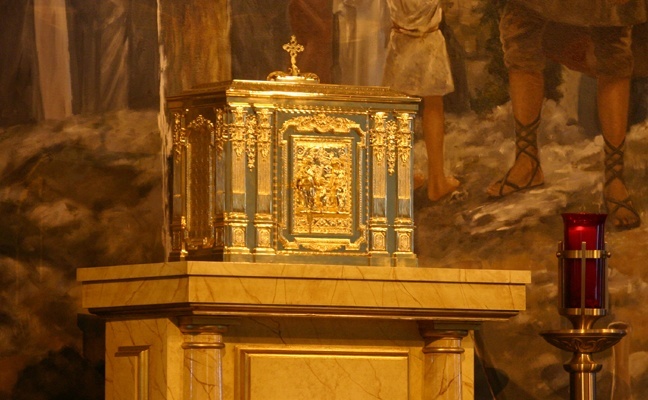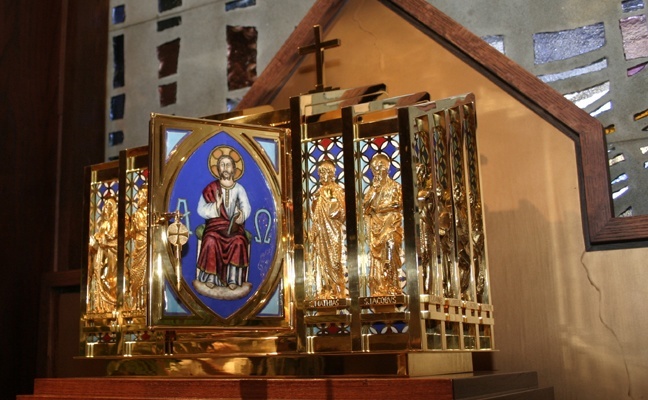By Anne DiBernardo - Florida Catholic
Photographer: ANA RODRIGUEZ-SOTO | FC For years, the tabernacle of St. John the Apostle Parish in Hialeah has been located in the back of the main altar.
MIAMI | When St. Gregory Parish in Plantation decided to renovate the church, the renovation committee and the pastor, Msgr. Noel Fogarty, decided that the tabernacle, which had been situated to the left of the main altar, would be given greater honor if it were placed at the center of the altar.
The decision of where to place a tabernacle — on the main altar, to the side of the main altar, or in a separate chapel altogether — is often a decision fraught with controversy.
But Father James Fetscher, pastor of St. Louis Parish in Pinecrest, says those controversies don't touch the heart of the matter. "People's attitude toward the Eucharist determines reverence, not location."
"It isn't a simple black and white issue," said Msgr. Terence Hogan, rector of St. Mary Cathedral and director of the archdiocesan Office of Worship, who holds a doctorate degree in liturgy from the Pontifical University of Sant' Anselmo in Rome.
He explained that in the early days of the church the tabernacle was located in side chapels off the main altar. (A visit to any church in Rome, including St. Peter's, confirms this.) Not until the 1500s or so was the tabernacle moved to the center of the altar, partly in response to the Protestant Reformation's denial of the real presence of Christ in the Eucharist.
Vatican II reintroduced the idea that the emphasis during Mass should be on the sacrifice taking place at the altar, rather than on a person's private prayer, so the tabernacle was moved back to the side as in ancient days.
"The provisions set forth in the General Instruction of the Roman Missal regarding the arrangement and furnishing of churches for the celebration of the Eucharist give the bishop an array of options of where the tabernacle should be. It can be on the side or on the main altar," Msgr. Hogan said.
"Separate spaces make a clearer understanding about the nature of what each of these moments is," said Father Fetscher, emphasizing the distinction between reservation, adoration and the communal celebration of the Eucharist.
St. Louis' tabernacle is not in the main sanctuary but in a chapel designated for perpetual adoration that is organically connected to the church building.
"If the tabernacle was in the main sanctuary, it would change the nature of people's attitude in the place — not that we turn into the local meeting of the Elks club, but it is the people who are the church. The building is the house for God's people," said Father Fetscher, also a former director of the archdiocesan Office of Worship.
Some people say, however, that the location of the tabernacle influences the degree of reverence towards the Eucharist.
According to Lori Westerman, a parishioner at St. Gregory and a member of the renovation committee, it was Msgr. Fogarty who expressed a desire to relocate the tabernacle from the side of the altar to the center of the altar.
"He feels the center is the location that pays the highest reverence to the Blessed Sacrament," she said, adding that the rest of the committee supported the move.

Photographer: ANA RODRIGUEZ-SOTO | FC
St. Martha Parish in Miami Shores located its tabernacle behind the main altar after a renovation in 2007.
"We wanted to promote an increased reverence for God instead of pushing him off to the side and we wanted to pay reverence to him in a positive, meaningful way," Westerman said. "The location of the tabernacle was the one big thing we wanted adjusted."
Her views are reinforced by her memories of going to church as a young girl and seeing the tabernacle at the center of the altar.
Msgr. Fogarty said that his decision to move the tabernacle was prompted by Cardinal Francis Arinze's call to the world's bishops to increase reverence for Jesus' true presence in the Eucharist.
Once St. Gregory's church is fully renovated, the tabernacle will be conspicuously situated, behind the altar on a pedestal that is higher than the altar.
Over the years, other parishes such as St. Augustine in Coral Gables and Blessed Trinity in Miami Springs also have moved their tabernacle from the side of the altar to the center.
Not everyone agrees.
Liliana Tufel, a member of Our Lady of the Lakes Parish in Miami Lakes, says placing the tabernacle in a chapel or side altar actually increases the level of reverence.
"When attending several churches with the tabernacle at the center of the altar, I have witnessed people being very reverent during the Mass but then lingering in the church after Mass talking, and little kids running back and forth with no longer the sense of reverence that was kept during Mass — yet the tabernacle remained in front of them at the altar. People also walked back and forth past the tabernacle without a sign of reverence."
At Our Lady of the Lakes, the tabernacle is kept in a separate chapel, where only those with a prayerful purpose enter. People still linger in the church and talk after Mass, and the little kids run around, but the tabernacle — and those praying before the Blessed Sacrament — are not disturbed. Proper reverence is observed.
Frank Alter, who attends San Francisco y Santa Clara, a mission chapel of Corpus Christi Parish in Miami, disagrees.
"The tabernacle belongs in the center behind the altar, which is in keeping with the Church's norms on being in a prominent position whereby the Blessed Sacrament can be reverenced accordingly," Alter said.
"When I see that the tabernacle is in the church it alerts me to stop talking and realize where I am. I don't like bare churches," said Phillip Melon, who admitted he does not attend Mass regularly. "I miss the feeling that there is a spirit there. The lack of reminders does nothing to increase my faith, rather, I feel like I am in an assembly hall or at a town meeting. There is no sense of awe."
While the bishop has the ultimate say as to where tabernacles are located in the churches in his diocese, the Church's teaching was best expressed by Pope John Paul II in his document, Inaestimabile Donum, issued in 1980:
"The tabernacle in which the Eucharist is kept can be located on an altar, or away from it, in a spot in the church which is very prominent, truly noble, and duly decorated or in a chapel suitable for private prayer and for adoration by the faithful."


Comments from readers
For Fr. James Fetscher, pastor of St. Louis Parish in Pinecrest (talk about location!), to say that the location of the tabernacle does not touch the heart of the matter is unacceptably naive and disingenuous coming from an individual who we must assume knows better.
Father is quoted as saying: �People�s attitude toward the Eucharist determines reverence, not location.� If that is so, then why doesn't he locate the priest's chair at the side of the sanctuary instead of right smack in the location of highest honor in the sanctuary?
I can just imagine Fr. Fetscher telling his Pinecrest parishoners: "People's attitude toward their house determines the property taxes they pay, not location." Right!
Let me see if I get this right. Our Lord in the Blessed Sacrament can have His tabernacle pushed off from the central and most visible location in the sanctuary, but the priest, a mere mortal, can sit right in the center of the sanctuary? Fr. Fetscher, despite all his theological training, may not see anything wrong with this picture, but us peasants certainly do! Proving perhaps, that seminary training does not necessarily help a person understand better the simple, down to earth, things of the Faith or of life.
I congratulate Msgr. Noel Fogarty for "getting it right!" Let's pray more priests understand things as he does.
�When attending several churches with the tabernacle at the center of the altar, I have witnessed people being very reverent during the Mass but then lingering in the church after Mass talking, and little kids running back and forth with no longer the sense of reverence that was kept during Mass � yet the tabernacle remained in front of them at the altar. People also walked back and forth past the tabernacle without a sign of reverence.�
However, I don't beleive this is much different when it is to the side. And still this could provide an opportunity to remind these people and children about Christ's true presence in the Eucharist and thus in the tabernacle.
I understand that the tabernacle at Our Lady of the Lakes is in a seperate chapel. While this may ensure reverence is maintained, I'm not certain I like the idea of the tabernacle not being visible to the congregation before, during and after mass.
I suppose I, too, prefer the reminders and a sense of awe.
This does bring up a question as well. I was told that when you genuflect when entering and exiting a pew, that you do so in reverence of the tabernacle. If this is true, then if the tabernacle is not present is there any need to genuflect?